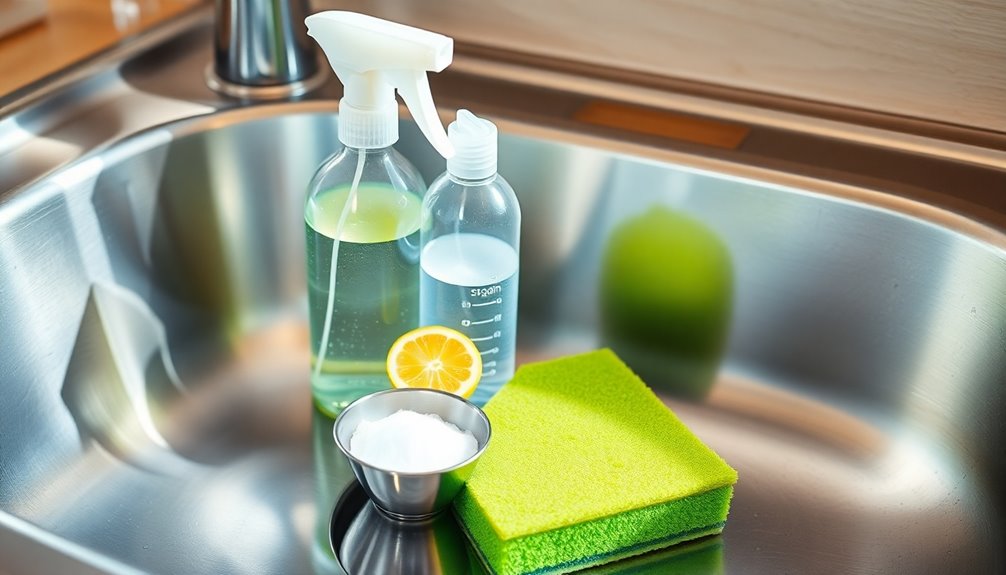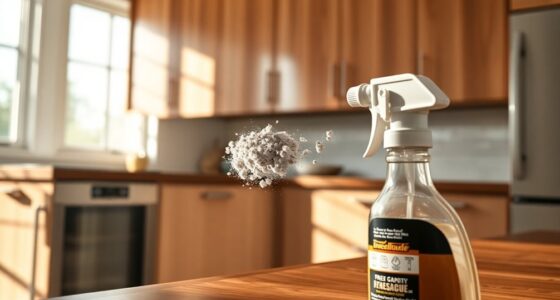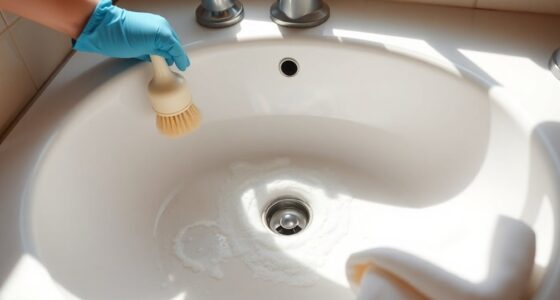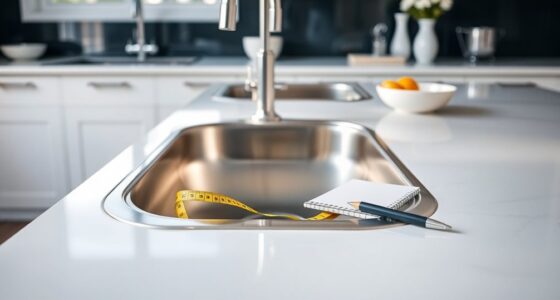To disinfect your kitchen sink without bleach, start by cleaning it with warm, soapy water. Then, spray hydrogen peroxide evenly over the surface and let it sit for at least 30 seconds. Alternatively, sprinkle baking soda and pour vinegar over it to create a fizzing reaction; let it sit for 10-15 minutes before rinsing. These methods effectively kill germs while being safe for your family and pets. Stick around to discover more tips on kitchen hygiene!
Key Takeaways
- Use hydrogen peroxide by spraying it on the sink and letting it sit for at least 30 seconds to kill germs effectively.
- Combine baking soda and vinegar; sprinkle baking soda, then spray vinegar to create a fizzing reaction that disinfects the sink.
- Wipe the sink with white vinegar after each use to maintain cleanliness and prevent bacteria buildup between deep cleans.
- Clean the sink thoroughly with soap and warm water before using any disinfecting agents for maximum effectiveness.
- Avoid harsh chemicals like bleach; opt for natural alternatives to create a safer environment for food preparation and family health.
Importance of Disinfecting Your Sink
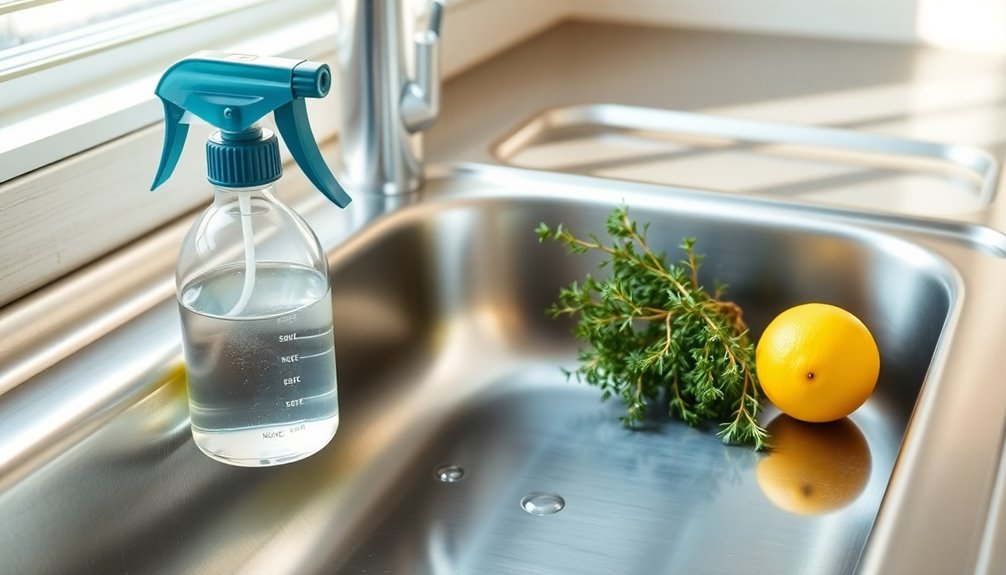
Your kitchen sink is a hotspot for harmful bacteria like E. Coli and Salmonella. Disinfecting it regularly is essential to prevent foodborne illnesses that can arise from contaminated surfaces.
When you clean your sink, you're ensuring that germs don't transfer to your sponges, cutlery, or food, which helps maintain a safe environment for cooking. Experts recommend disinfecting your sink at least once a week, especially after handling raw meat, to effectively combat bacteria and uphold hygiene standards.
A clean, disinfected sink greatly contributes to overall kitchen cleanliness. Consider using alternatives like hydrogen peroxide for disinfecting, particularly in homes with children and pets, to create a safer space for everyone.
Prioritize regular cleaning to keep your kitchen healthy.
Cleaning vs. Disinfecting
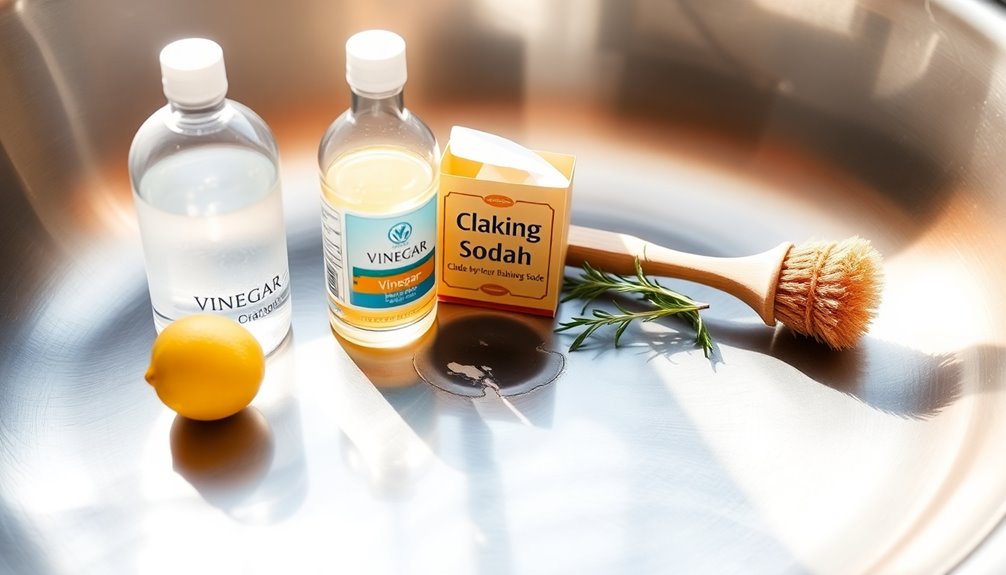
Cleaning and disinfecting are two distinct yet interconnected processes vital for maintaining a hygienic kitchen. When you clean, you remove visible dirt, food particles, and stains from surfaces.
However, cleaning alone doesn't eliminate bacteria, which is why disinfecting is important. Disinfecting specifically targets and kills harmful bacteria that can linger, even in seemingly clean sinks.
To guarantee food safety, you should disinfect your sink at least once a week. Common household disinfectants like vinegar and hydrogen peroxide are effective options that won't expose you to harsh chemicals.
Step #1: Cleaning the Sink
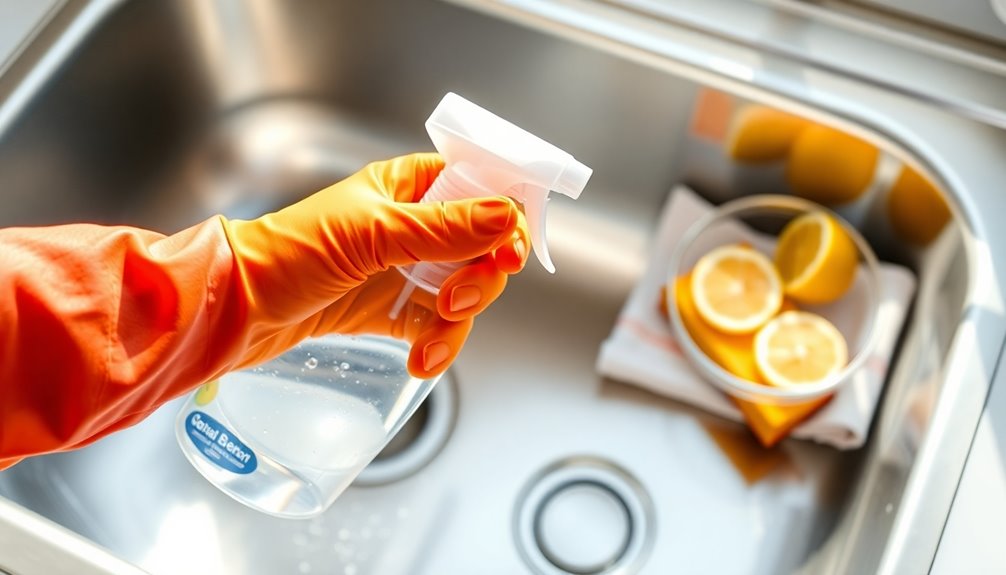
Start by clearing the sink of any food scraps and debris to create a clean surface for sanitization.
Next, mix dish soap with warm water and use this solution to scrub the sink thoroughly. This will help lift dirt and grime effectively.
Dampen a clean sponge with water and wipe down the surface, following the grain if your sink is stainless steel to prevent scratches.
After scrubbing, rinse the sink thoroughly with warm water to remove any soap residue and loose particles. Make sure to get into all corners and crevices for a complete clean.
Finally, allow the sink to dry completely before moving on to the disinfection step for maximum effectiveness.
Step #2: Disinfecting the Sink
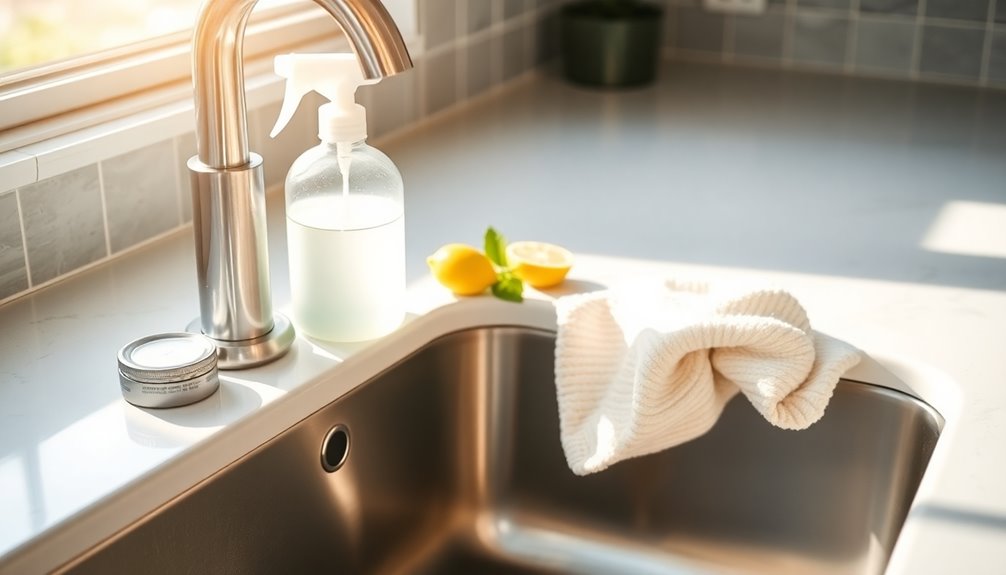
With the sink now clean and dry, it's time to focus on disinfecting.
To disinfect your kitchen sink effectively, spray hydrogen peroxide evenly across its surface or dampen a cloth with it to wipe down all areas. Let the hydrogen peroxide sit for at least 30 seconds to kill germs and bacteria.
For a bleach alternative, consider using baking soda and vinegar: sprinkle baking soda, then pour vinegar over it, and let the fizzing action work for a few minutes.
After either method, rinse the sink thoroughly with water to remove any residue.
Regularly disinfecting your sink at least once a week helps maintain a clean and sanitized kitchen, especially after handling raw meat or preparing food.
Method #1: Vinegar and Hydrogen Peroxide
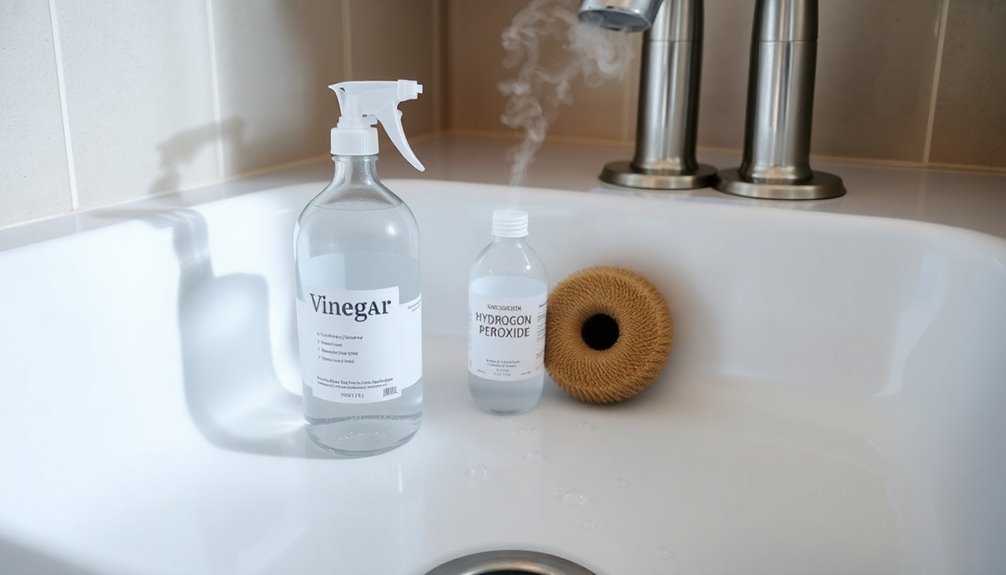
Using vinegar and hydrogen peroxide together creates an effective disinfecting combination that's safe for all surfaces in your kitchen sink.
This simple application process allows you to eliminate germs without harsh chemicals.
You'll appreciate how easy it's to keep your sink clean and fresh!
Effective Disinfecting Combination
Disinfecting your kitchen sink can be both effective and safe with a powerful combination of vinegar and hydrogen peroxide.
To start, clean your sink thoroughly with soap and water to remove any food particles.
Next, spray hydrogen peroxide evenly across the surface, letting it sit for 5-10 minutes to effectively disinfect.
After that, spray distilled white vinegar on the sink and allow it to dwell for another 5 minutes.
This natural disinfectant not only eliminates harmful bacteria but also protects your stainless steel surfaces from corrosive damage often caused by bleach.
Remember, always apply the two solutions separately—never mix them—to avoid producing harmful gases.
This method will help you disinfect your kitchen safely and efficiently.
Safe for All Surfaces
A clean kitchen sink is essential for maintaining a healthy cooking environment, and you can achieve that without harsh chemicals.
Using hydrogen peroxide and distilled white vinegar is a safe and effective method for disinfecting your sink. This combination works on various surfaces, including stainless steel and porcelain, guaranteeing your cleaning routine is versatile.
Start by cleaning your sink with soap and water to remove grime. Once clean, spray hydrogen peroxide and let it sit for 5-10 minutes to kill germs.
Next, apply distilled white vinegar and allow it to dwell for another 5 minutes.
Simple Application Process
After ensuring your sink is safe for all surfaces, you can easily apply a simple disinfection method that relies on vinegar and hydrogen peroxide.
Start by cleaning the sink with dish soap and water to remove any dirt and grime.
Once it's clean, spray hydrogen peroxide evenly across the surface of the sink. Let it sit for at least 30 seconds to disinfect effectively.
Next, spray distilled white vinegar over the hydrogen peroxide and allow it to dwell for about 5 minutes.
Use a sponge to gently scrub all areas of the sink, ensuring you cover every spot.
Finally, rinse thoroughly with water to wash away any residual disinfectants.
This method is a safe, non-toxic alternative to bleach.
Method #2: Baking Soda and Vinegar
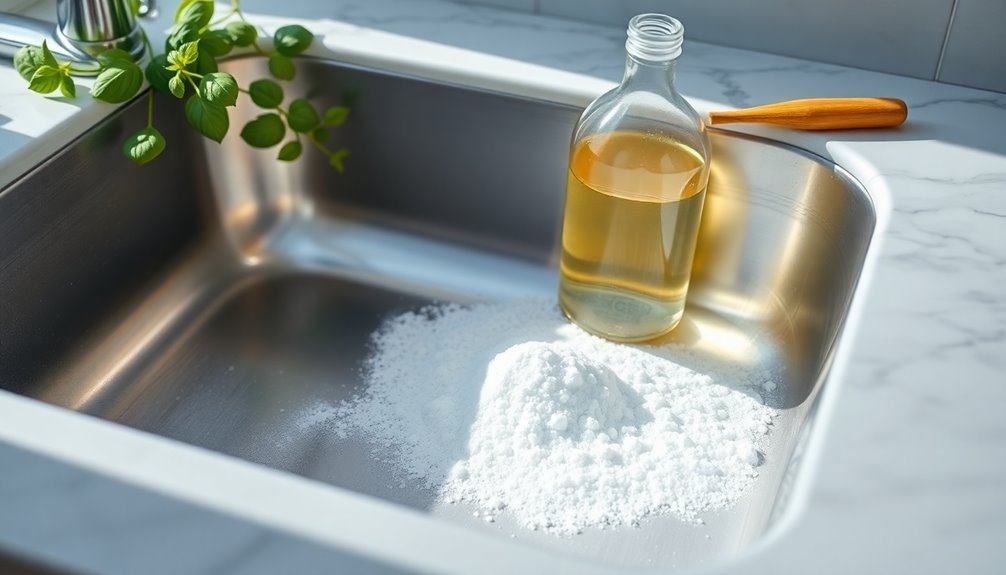
Using baking soda and vinegar together creates an effective cleaning reaction that tackles grime and disinfects your sink.
This combination not only lifts dirt but also neutralizes odors, leaving your kitchen smelling fresh.
Effective Cleaning Reaction
When you want to disinfect your kitchen sink effectively, the baking soda and vinegar method creates a powerful cleaning reaction. Start by rinsing your sink to remove loose debris, then sprinkle a generous layer of baking soda across the surface. Next, spray or pour vinegar over it to initiate the fizzing action, which helps lift grime and kill bacteria. Let the mixture sit for 10-15 minutes before scrubbing the sink with a sponge or brush. Rinse thoroughly with warm water to wash away residues, leaving your sink clean and sanitized. This eco-friendly alternative not only disinfects but also helps keep your kitchen fresh, promoting a healthier lifestyle by maintaining cleanliness and hygiene.
| Step | Action |
|---|---|
| 1. Rinse | Remove loose debris |
| 2. Apply Baking Soda | Sprinkle generously |
| 3. Add Vinegar | Spray or pour to create fizz |
| 4. Wait | Let sit for 10-15 minutes |
| 5. Scrub and Rinse | Clean and disinfect your sink |
Odor Neutralization Benefits
One of the standout benefits of the baking soda and vinegar method is its ability to neutralize unpleasant odors in your kitchen sink.
Baking soda acts as a natural deodorizer, effectively combating odors while gently scrubbing away grime. When you combine it with vinegar, the fizzing reaction not only lifts stubborn stains but also eliminates those lingering smells caused by food particles and bacteria in the drain.
This method disinfects your sink safely, making it suitable for all materials, including stainless steel and porcelain, without risking corrosion. Plus, it's an eco-friendly choice, minimizing the need for harsh chemicals.
Using baking soda and vinegar regularly can keep your sink fresh and inviting, especially in homes with children and pets. Additionally, this approach aligns with natural cleaning solutions that avoid harmful substances often found in commercial cleaners.
How Often To Disinfect Your Sink

Regularly disinfecting your kitchen sink is essential for maintaining a hygienic cooking environment. Experts recommend doing this at least once a week to effectively combat germs and bacteria that accumulate during food preparation. If you cook frequently, you might need to disinfect your sink more often, especially after handling raw meats or messy food items. This practice is vital for food safety, as kitchen sinks can harbor harmful bacteria that lead to infections like E. Coli and Salmonella. Incorporating daily cleaning practices, such as wiping the sink with white vinegar after each use, can help maintain hygiene between deeper disinfecting sessions. Additionally, using anti-inflammatory foods in your diet can support your immune system, which is crucial for overall health and hygiene.
Extra Cleaning Tips for the Kitchen
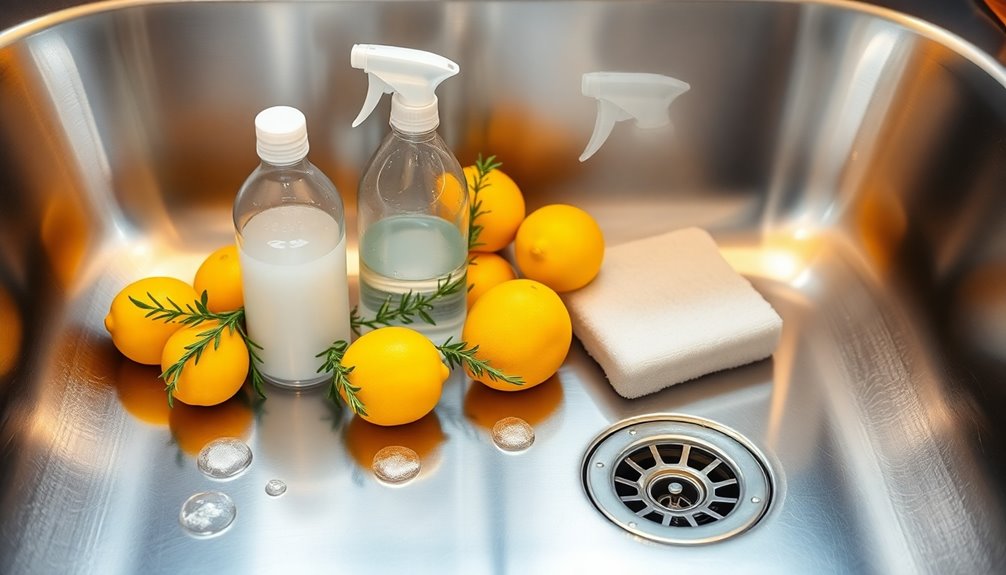
To keep your kitchen sparkling and germ-free, it's crucial to adopt extra cleaning tips beyond just disinfecting the sink. Regularly clean your kitchen sink and surfaces to prevent harmful bacteria from food waste.
After handling raw meat, immediately clean and disinfect the sink to eliminate germs like Salmonella and E. Coli. Use natural disinfectants like vinegar and hydrogen peroxide instead of harsh chemicals to maintain a safe environment, especially for kids and pets.
Incorporate a routine by wiping down surfaces daily with white vinegar to deter buildup. These practices not only keep your kitchen clean but also guarantee effective cleaning and disinfecting throughout your space. Engaging children in educational activities can further promote a healthy kitchen environment.
Avoid using bleach to create a healthier kitchen atmosphere.
Frequently Asked Questions
How Do I Sanitize My Kitchen Sink?
To sanitize your kitchen sink, start by cleaning it with dish soap and warm water. This removes dirt and prepares the surface.
Next, spray hydrogen peroxide and let it sit for at least 30 seconds. Alternatively, mix baking soda with water to form a paste, scrub it on, and rinse with vinegar for added effectiveness.
For a fresh scent, scrub with lemon juice and salt, then rinse thoroughly. Regular sanitation keeps your sink germ-free!
What Is the Best Disinfectant for Kitchen Sinks?
Imagine your kitchen sink as a stage where daily meals take center stage. To keep this stage pristine, you need the right disinfectant.
Hydrogen peroxide is a top choice; it's non-toxic and safe for your family and pets. Alternatively, distilled white vinegar works wonders against germs.
For a natural boost, try a baking soda and vinegar combo. Regular disinfection is key, so make it a weekly ritual to guarantee a safe cooking environment.
Does Vinegar Disinfect Kitchen Sink?
Yes, vinegar does disinfect your kitchen sink! When you spray it directly onto the surface and let it sit for 5-10 minutes, it effectively kills around 99% of bacteria and many viruses.
For even better results, you can combine vinegar with baking soda to tackle grime while disinfecting.
Just remember to clean with soap and water first, then follow up with the vinegar for a thorough clean that's safe for your home.
How Do You Clean a Sink Without Bleach?
Cleaning a sink without bleach is like giving it a fresh breath of air.
Start by clearing out any food scraps, then grab your dish soap and warm water, scrubbing away dirt and grime.
For extra freshness, sprinkle some baking soda and drizzle vinegar on top—watch it fizz!
Rinse thoroughly.
Finish off by giving your sink a spray of white vinegar to keep it sparkling clean and free from buildup.
Conclusion
In summary, keeping your kitchen sink disinfected without bleach is simple and effective. By using natural solutions like vinegar and hydrogen peroxide or baking soda and vinegar, you can guarantee a clean and safe space for food prep. Remember, cleanliness is next to godliness, so make it a habit to disinfect regularly. With these easy methods, you can tackle germs head-on and create a healthier kitchen environment for you and your family.
